BEEKEEPING ACCESSORIES
Bee hives were designed after the discovery of “Bee Space” or “Bee Passage” by L.L.Langstroth. It is the optimum distance to be left in between two adjacent comb surfaces in a bee hive which is essential for normal movement and functioning of bees. It is too small for comb construction and is too large for propolis deposition. It varies with honeybee species. Eg. For Indian bees – 7-9 mm and Italian bees – 10 mm
Bee keeping in movable frames
- It is the noblest innovation in bee keeping which has several advantages.
- Hive volume can be increased or decreased based on need
- Easy to assess food store position
- Bees can be fed artificially
- Brood development can be effectively monitored
- Artificial queen rearing can be done
- Old and damaged combs can be removed
- Bees can be easily observed with least disturbance
- Honey can be extracted without damaging the comb
- More honey can be extracted by giving more honey supers
Hive bodies painted externally will last longer. The colour of the paint shall be white, blue, yellow or green. White is generally preferred for hive construction. It offers durability, flexibility easy handling and improves the colony efficiency in regulating hive interior temperature and humidity.
Materials: Bee hives are constructed mainly with seasonal timber such as teak, kail or toon. The timber should be free from insect holes, dead knots, shakes, splits and cracks. The thickness of the wooden walls should be 20 mm.
Besides the hives, the beekeepers need equipment and implements like the hive stand, nucleus box and smoker. The industry also needs equipment and machinery for handling and processing of honey, beeswax, for manufacture of comb foundation sheets, and for other operations.
Types of bee hives
Different types of bee hives were in use in various parts of our country. They are pot hive, book hive, Madhusagar hive, house hive, nucleous hive, single walled and double walled Dadant hives, British standard hive, Langstroth hive, Jeolikote hive and Newton hive. Of all these types, the one designed by Rev.Fr.Newton is the most popular one in South India. Newton’s hives, BIS hives and Marthandam hives are suited for rearing Indian bees. Langstroth hives are suited for rearing Italian bees.
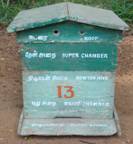 |

|
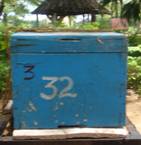
|
Newton’s bee hive |
Bis hive |
Marthandam hive |
BIS HIVE HAVING FOLLOWING PARTS
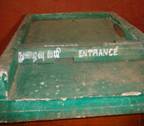 |

|

|
FLOOR BOARD |
BROOD CHAMBER |
WOODEN FRAMES |
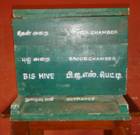
|

|
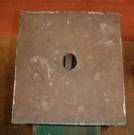
|
SUPER CHAMBER |
SUPER CHAMBER WITH WOODEN FRAMES |
TOP COVER |
Latest BIS Specifications for bee hives
Type |
Bee space in mm |
No.of frames |
Bee species |
A |
7 or8 |
10 or 8 or 4 |
A. cerana |
B |
9 |
10 or 8 or 4 |
A. cerana |
C |
10 |
10 or 6 |
A. mellifera |
Newton’s bee hive has the following parts made of wood
a) Floor board: 14” x 91/2” in size with an extension in front which serves as an alighting board.
b) Brood chamber: -93/4 x 81/4” x 63/4” in size with an entrance slit of 31/2” x 3/8” at the base; it is mounted over the floor board
c) Wooden frames: Seven separate woodedn frames 81/4” x 53/4” x6” in size and 7/8” broad: they are hung inside the brood chamber
d) Super chamber: 93/4” X 81/4” X31/8” in size: it is kept over the brood chamber
e) Top cover: It is board having same dimensions of brood or super chamber. In the centre there is an opening covered with wire gauge. It is kept on super or brood chamber.
It is the top cover of the hive. It is a box like structure with a opening bottom portion. The portion of the box is covered with zinc or tin sheets. The bottom open portion fits on the brood or super chamber and completely covers them. There are two holes covered with wire mesh in the front and back side for ventilation.
The wooden frames inside the hive should have a space of about ¼” in between any two. The hives are painted yellow, light blue, green or pink but never with red, black or grey. Green and light blue colours are preferable. The hive has to be fixed over a termite proof stand of about a meter height and kept in a shady place under trees of under a roof. It has to be protected from ants by providing oil-bands on the stand or water-trought under them.

|
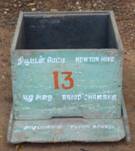
|
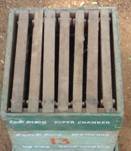
|

|
Floor board |
Brood chamber |
Wooden frames |
Top cover |
Parts of hive: The bee hive consists of the following parts
i) Bottom board (or) Floor board: It forms the floor of the hive made up of a single piece of wood or two pieces of wood joined together. Wooden beading are fixed on to the lateral sides and back side. There is a removable entrance rod in the front side with two entrance slits to alter the size of the hive entrance based on need. The board is extended by10 cm in front of the hive body which provides a landing platform for bees. Size of alighting board is 40x28 cm (BIS hive).
ii) Brood Chamber: It is a four sided rectangular wooden box of cross section without a top and bottom. It is kept on the floorboard. A rabbet is cut in the front and back walls of the brood chamber. The brood frames rest on the rabbet walls. Notches on the outer surface of the side walls are useful for lifting. The four sides of the chamber are joined by special joints. In brood frames, bees develop comb to rear brood. Size of brood frame is (outer dimensions) 29x29x17 cm. There will be 8 frames. Len!gth and height of frame is 20.5x14.0 cm (BIS hive).
iii) Super Chamber: It is kept over the brood chamber and its construction is similar to that of brood chamber. Super frames are hung inside. The length and width of this chamber is similar to that of brood chamber. The height may be also similar if it is full depth super as in Langstroth hive. But the height will be only half if it in a shallow super as in Newton's hive. Surplus honey is stored in super chamber. The height of the chamber is 9.5 cm. The inner height of the frame is 6.0 cm (BIS hive).
iv) Hive Cover: It insulates the interior of the hive. In Newton's hive it has sloping planks on either side. On the inner ceiling plank there is a square ventilation hole fitted with a wire gauze. Two holes present in the front and rear also help in air circulation.
In Langstroth hive and BIS hive, the hive cover consists of a crown board or inner cover and an outercover.The inner cover is provided with a central ventilation hole covered with wire gauze. The outer cover is covered over with a metallic sheet to make it impervious to rain water. Circular ventilation holes covered by wire gauze help in air circulation. It protects the hive against rain and sun.
v) Frames: The frames are so constructed that a series of them may be placed in a vertical position in the brood chamber or the super chamber so as to leave space in between them for bees to move. Each frame consists of a top bar, two side bars and a bottom bar nailed together. Both the ends of the top-bar protrude so that the frame can rest on the rabbet.
The depth of the super frame is less than that of the brood frame in Newton's hive and ISI hive. But in Langstroth hive it is same as that of brood frame. A groove present underneath the top bar is useful to fix the comb foundation sheet. Holes present on the side bars are useful for wire reinforcement. Joined wire of 28 gauge is used for wiring frames. The height of the side bar reflects the depth of the super.
Other accessories
1. Comb foundation sheet
Made of wax; it is artificially provided for the colonies during honey flow season pure by cutting them to a proper conical size and attaching them to super frames by means of thread or fibre; It is a thin sheet of bee wax embossed with a pattern of hexagons of size equal to the base of natural brood cells on both sides. The size of the hexagon varies with bee species. The sheet is fixed to the frames on fine wires threaded through holes in the side bars and stretched tight. A spur or an electrical heating device is used to embed wires into the comb foundation sheets which are prepared in a comb foundation mill. The bees construct superstructure of comb cells over the sheet.
Advantages
. Bees have to add cell walls only
. Combs will be vertical
. Cell size will be uniform
. Combs are strong and sturdy
. Better and more honey harvest is made possible
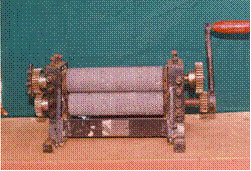 |
Comb foundation sheet |
2. Embedder
It is a small tool with a spur or round wheel on the top. It is used to fix the comb foundation sheet on the wires of the frame. Electric wire is also used for this purpose which is useful to reinforce the comb and give extra strength to the comb.
3. Synthetic Combs
It is made up of high density polythene (plastic). It can be used in both super and brood chamber. Since the comb is fully molded, bees only put wax caps on the cells.
Advantages
More honey can be extracted.
Combs can be easily sterilized
Resist wax moth attack
Combs are not damaged during honey extraction
4. Dummy division board/Movable wall
It is a wooden board slightly larger than the brood frame. It is placed inside the brood chamber. It prevents the bees from going beyond it. It can be used as a movable wall there by limiting the volume of brood chamber which will help the bees to maintain the hive temperature and to protect them from enemies. It is useful in managing small colonies.
5. Porter bee escape board or super clearer
It is a device which allows the bees to go through a self closing exit. eg. Spring bee escape or wire gauze cone. A board having one way passage in the center can also be used. It is kept in between honey super and brood chamber. It is used for clearing the bees from super for extracting honey.
6. Drone excluder or drone trap
It is a rectangular box with one side open. The other side is fitted with queen excluder sheet. At the bottom of the box there is a space for movement of worker bees. There are two hollow cones at the bottom wall of the box. Drones entering through the cones into the box get trapped. The narrow end of the cone is wide enough to let the bees pass out but not large enough to attract their attention or reentry. This device is used at the entrance to reduce the drone population inside the hive.
7. Swarm trap
It is a rectangular box used to trap and carry the swarm. It is fixed near the hive entrance with one (or) two combs inside during the swarming period. This box traps and retains the queen only. But the swarm coming out from the hive reenter the hive and settles on the comb, since the queen is trapped. Thus the swarm is induced to settle in the frame, which can now be transferred to a hive at a desired place.
8. Pollen trap
Pollen trapping screen inside this trap scrapes pellets from the legs of the returning foragers. It is set at the hive entrance. The collected pollen pellets fall into a drawer type of receving tray.
9. Division Board / Sugar Feeder
It can be hung along with the frames. A wooden strip or cut bits of leaves kept inside serve as float which prevents the drowning of bees in the sugar syrup.
10. Hive tool
It is a piece of flattened iron with flattened down edge at one end. It is useful to separate hive parts and frames glued together with propolis. It is also useful in scrapping excess propolis or wax and superfluous combs or wax from various parts of the hive.
11. Queen excluder
It is made up of Perforated zinc sheet. The slots are large enough to allow the workers to pass through but too narrow for the queen. A wire grid/dividing grid with parallel wire mounts can also be used as a queen excluder. It is inserted in between the brood frames in single storey hive.
Uses: It is useful to confine the queen to brood chamber. But it allows the workers to have access to super. It prevents the queen from laying eggs in honey combs. It is also used in producing royal jelly in queen rearing and in forming multi-queen colonies.
12. Queen Gate
It is a piece of queen excluder sheet. It is fitted on the slot of entrance gate. It confines the queen inside the hive. It is useful to prevent swarming and absconding. It also prevents the entry of bee enemies like wasps into the hive.
13. Queen Cage
It is a cage made up of wire gauze. It is useful for queen introduction.
14. Queen Cell Protector
It is a cone shaped structure made of a piece of wire wound spirally. It fits around a queen cell. It is used to protect the queen cell, given from a queen right to a queenless colony until its acceptance by bees.
15. Smoker
The smoker is used to calm bees and drive away bees from super. It is a small tin with an elastic bulb at one side; rags of cloth or wood shavings can be burnt inside and the smoke expelled to any desired spot. Eco-friendly smoke for driving away rock bees: Special smoke generated by using Charcoal, coconut husk and chicken feathers. Use of bucket smoker effectively drives out rock bees.
 |

|
Smoker |
Driving away the bee |
16 .Protective dress
i) Bee veil: It is worn over face for protection against stings. It should be made up of black nylon netting screen (12-mesh). Screen wire (or) fabric are the preferred materials Veils should be made to fit snugly around the hat and to fit tightly to the shoulder leaving enough space between veil and face.
ii) Overalls: White overalls are occasionally worn. Light coloured cotton materials are preferable since they are cooler and create less risk for antagonizing bees.
iii) Gloves: Bee gloves are made of tightly-knit cloth (or) soft leather. They cover the fore arms. The gloves are useful for the beginners to develop confidence in handling bees. But handlings of frames will be cumbersome if gloves are worn.
iv) High boots: A pair of gum boots will protect the ankles and prevent bees from climbing up under trousers.
17. Bee brush
A soft-camel-hair brush is used to brush the bees off the honeycomb before it is taken for extraction.
18. Decapping knife
Single (or) double edged steel knife is used for removing wax cappings from the honey comb.
19. Honey extractor
This equipment consists of cylindrical drum containing a rack or box inside to hold the super frames. The box is fixed to a rod at the centre and it can be rotated by a set of two gear wheels. The frames with, honey cells are decapped by a sharp knife after dipping it in hot water and fixed to the slots provided in the box which is rotated by the handle. The rotation should be very gentle and slow at first and the speed of revolution increased gradually. With some experience the correct speed can be learnt. The honey in the cells is forced out in droplets by the action of the centrifugal force and can be collected in vessels through an exit in the drum. As cells are constructed on both sides of the comb, by changing the sides of the frames and again rotating, the honey contained in the cells on the other side can also be drained off. Particular care should be taken while handling heavy combs or those which are flimsily attached to the frames.
There is another type of honey extractor known as the churn staff honey extractor or rock bee honey extractor. It consists of a rectangular wooden frame fixed to a thick wooden rod to effect the rotation. The frame is made to hold a wire gauge cage and is provided with a small peg at bottom. The latter is received into a socket in the centre of another block of wood. The wooden block is fixed on tightly to the bottom of any ordinary vessel. The wire gauge cage with the uncapped honey combs is kept inside the frame and then the central shaft is rotated with a piece of rope as in the case of a country churn.
The extraction of honey should be done a distance away front the hive. Otherwise the workers get attracted by the odour of the honey and comb and may annoy the operator.
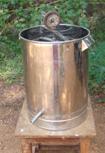 |
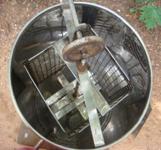
|
Honey extractor |
ACCESSORIES ARE AVAILABLE AT
TAMILNADU KADHI VILLAGE INDUSTRIES BOARD
CARPENTRY AND BLACKSMITH MEDIUM WORKSHOP
KUMARNAGAR,
TIRUPUR-03
Phone no-04212473200
In addition, packaging and marketing of honey is also done by TamilNadu Kadhi Village Industries Board, TIRUPUR.
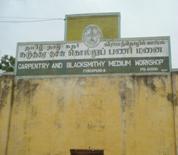
|
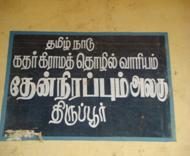
|
Accessories workshop |
Honey packing unit |
|




















